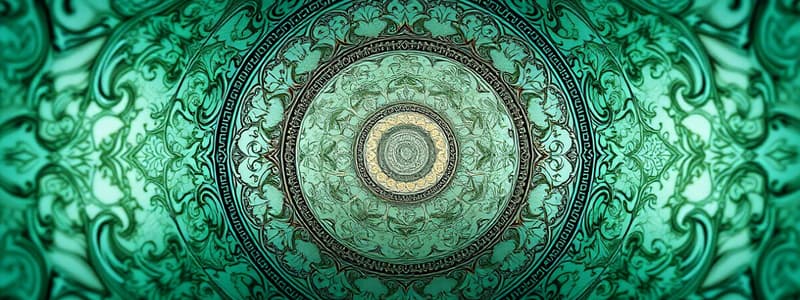Podcast
Questions and Answers
What characteristic distinguishes concave mirrors from convex mirrors?
What characteristic distinguishes concave mirrors from convex mirrors?
- Concave mirrors do not have a focal point.
- Concave mirrors can only reflect rays diverging from a single point.
- Concave mirrors can converge incident rays towards a focal point. (correct)
- Concave mirrors always produce virtual images.
Where is the focal point located in relation to a concave mirror?
Where is the focal point located in relation to a concave mirror?
- At a distance equal to half of the focal length from the vertex.
- At the vertex of the mirror.
- At a distance equal to the radius of curvature.
- Along the principal axis, between the vertex and center of curvature. (correct)
What happens to a real image formed by a concave mirror as the object moves closer to the focal point?
What happens to a real image formed by a concave mirror as the object moves closer to the focal point?
- The real image vanishes entirely.
- The real image begins to rotate.
- The real image becomes larger and clearer.
- The real image becomes smaller and less distinct. (correct)
To correctly mark the image formed by a concave mirror, which of the following steps is NOT necessary?
To correctly mark the image formed by a concave mirror, which of the following steps is NOT necessary?
Which statement about the image characteristics produced by a concave mirror is incorrect?
Which statement about the image characteristics produced by a concave mirror is incorrect?
Flashcards
Focal Point (F)
Focal Point (F)
The point on the principal axis where all reflected rays from parallel incident rays converge.
Focal Length (f)
Focal Length (f)
The distance between the focal point (F) and the vertex (V) of the concave mirror.
Virtual Image in Concave Mirror
Virtual Image in Concave Mirror
A concave mirror produces a virtual image when the object is placed between the focal point (F) and the mirror.
Real Image in Concave Mirror
Real Image in Concave Mirror
Signup and view all the flashcards
Image Size Variation
Image Size Variation
Signup and view all the flashcards
Study Notes
Concave Mirrors: Properties and Image Formation
- Concave mirrors are also known as converging mirrors because reflected rays converge at a point.
- Centre of Curvature (C): The point where all normals to the mirror intersect.
- Principal Axis: The line passing through the centre of curvature and perpendicular to the mirror's surface.
- Vertex (V): The point where the principal axis intersects the mirror.
- Focal Point (F): The point where rays parallel to the principal axis converge after reflection.
- Focal Length (f): The distance between the vertex and the focal point.
- Incident Ray through Centre of Curvature: This ray passes directly over the normal, having zero angle of incidence and reflection.
- Image Formation Steps (Object between F and Mirror):
- Draw the principal axis and concave mirror curve.
- Mark the focal point.
- Draw one ray parallel to the principal axis, reflecting through F.
- Draw a second ray passing through F, reflecting parallel to the principal axis.
- Draw a third ray passing through C, reflecting along the same path back through C.
- Extend the reflected rays behind the mirror to find the image.
- The intersection of these rays forms the image.
- Real vs. Virtual Images (Concave Mirrors):
- Real images are formed when the object is positioned at C, beyond C, or between C and F.
- Virtual images are formed when the object is between F and the mirror.
- A concave mirror does not produce an image if the object is placed at F.
- Image Size Variation: The real image in a concave mirror becomes smaller as the object moves from beyond C towards F.
Studying That Suits You
Use AI to generate personalized quizzes and flashcards to suit your learning preferences.
Description
Explore the fascinating properties of concave mirrors and how they form images. This quiz covers key concepts such as the focal point, focal length, and the steps involved in image formation. Test your understanding of these principles and their applications in optics.




